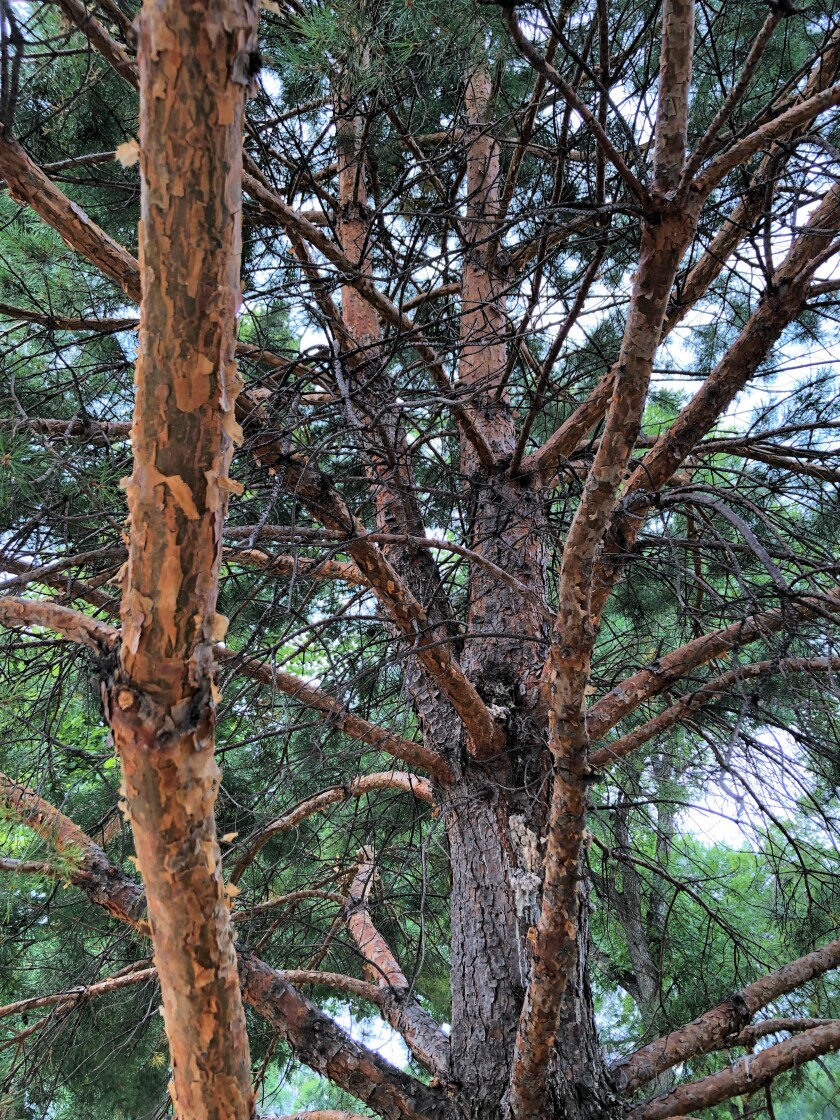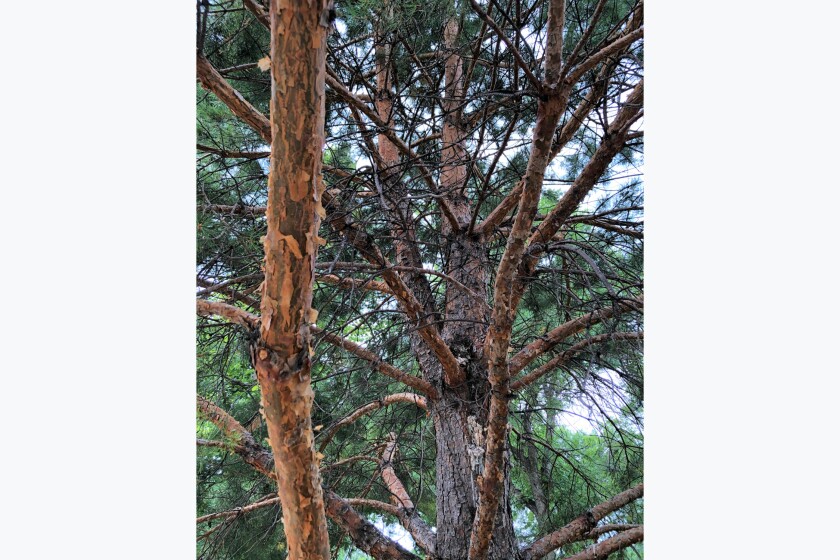Q: We just noticed that our pine tree has a lot of loose bark. I guess we’re not very observant because it looks like it’s been going on for some time. Is this due to the drought? We have not been watering the tree at all. Is it diseased and will it cause problems for neighboring trees? Any advice you could give us would be greatly appreciated. — Dorine F.
A: The peeling appearance of the bark on your Scotch pine branches is normal. In fact, one of the attractive features of Scotch pine is the striking, coppery, orange-colored bark that develops on main branches. The interesting bark also has a peeling texture as it ages, which is what you’re seeing.
ADVERTISEMENT
I did notice on the photos, though, an unrelated issue that might bear watching. Pine pitch is accumulating on some branches or trunks and must be exuding from wounds or openings.

If you’ve seen sapsucker or other woodpecker holes in the trunk, the sap is likely coming from these openings. If the activity of these birds is too frequent, with holes closely spaced, the tree's health can be affected as the flow of water and nutrients within the tree is disrupted.
It can be difficult to keep birds out of trees. Others in similar situations have tried scare devices hung from branches, including aluminum pie tins, balloons and owl or hawk decoys. Wrapping the trunk with burlap sometimes helps. Applying sticky Tanglefoot to the area of activity can be quite effective.
RELATED COLUMNS:
-
These 'good guy' insects are the cause of circular holes in dogwood leaves
-
North Dakota research farm is a hidden horticultural gem
-
Keeping your lawn alive during a drought
Q: A professional friend suggested gypsum might benefit my lawn because of the clay soil. Do you have any information on using gypsum and potential benefits? — Judy F.
ADVERTISEMENT
A: Gypsum has been greatly researched in North Dakota to determine its effect on problem soils. Research literature indicates gypsum can be beneficial in remedying difficult soils in localized areas that are high in sodium salts.
Gypsum doesn’t, however, improve the workability or texture of heavy clay soils, such as found in the Red River Valley. I wish it did, but unfortunately it doesn’t have that effect.
Gypsum is widely used in other parts of the country whose soil makeup and chemistry differs greatly from soil in the Upper Midwest. Our soils are generally plentiful in calcium, which is the main component of gypsum, and explains why gypsum isn’t widely recommended for our regional soils, except in fields where tests have revealed sodium to be problematic.
RELATED COLUMNS:
-
How a local gardener kept the birds from stealing his bumper crop of cherries
-
-
Gardening columnist shares best perennials for mid-summer bloom
Q: I’ve got many fall-blooming perennials, like asters and mums. I haven’t been able to water them much, but should I start doing so? Also, do tulip bulbs need to be watered when planting this fall? — Linda M.
A: I would definitely water fall-blooming perennials as regularly as you can, to help flower buds develop normally. The extended drought will likely diminish the bloom of many asters, mums and other fall flowers, as their energy and bud development are already likely stressed by this summer’s hot, dry weather.
A deep soaking once or twice a week will help. Mulching the soil with 3 to 5 inches of shredded wood product will help keep the soil cool and conserve moisture.
ADVERTISEMENT
Tulips and other fall bulbs should be watered immediately after planting in September or early October. These bulbs develop roots this fall, and moist soil is required. A light mulch of straw, shredded bark, leaves or untreated grass clippings will help retain moisture. If tulips are planted in soil that remains dry, next spring’s growth will likely be disappointing.
If you have a gardening or lawn care question, email Don Kinzler, NDSU Extension-Cass County, at donald.kinzler@ndsu.edu. Questions with broad appeal may be published, so please include your name, city and state for appropriate advice.













